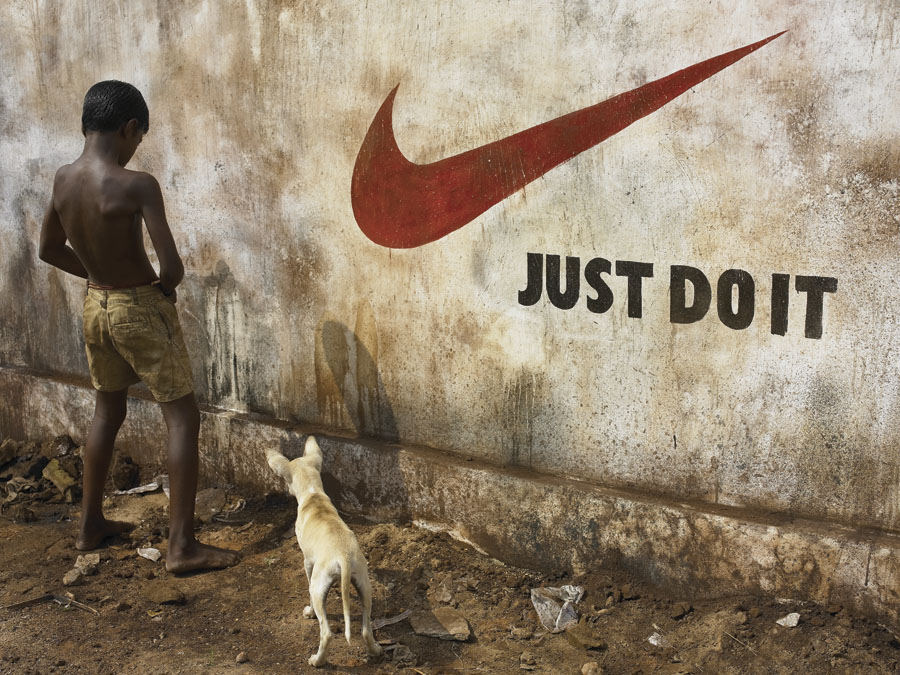The image above was photographed by Sharad Haksar, an award-winning advertising photographer and founder of advertising agency 1pointsize. I originally found the image on the blog Fresh Pics (http://freshpics.blogspot.com/2008/09/brand-irony-by-sharad-haksar.html) but the image is also available as part of Haksar’s portfolio on his personal website. The image, though it appears to be advertising Nike, is actually part of a series entitled “Brand Irony” which portrays ironic juxtapositions of famous brands around India. Besides offering a humorous look at ironic product advertising, Haksar's "Brand Irony" series seems to also address issues of globalization and overaggressive advertising. Although Haksar’s photo is not advertising the Nike brand per se, it appeals to the same audience of young and active people between the ages of 16 and 40. More generally, Haksar’s photo addresses anybody on the Internet with an interest in photograph and advertising, especially given its ubiquity on other advertising and photography related sites.
The initial emotions this image evokes stem from joy and surprise. The famous Nike Swoosh and its accompanying slogan “Just Do It” immediately inspires thrill and excitement in the viewer, due in large part because of Nike’s large media presence and association with athleticism. The image of the boy urinating on the wall as a dog looks on is humorous, especially in contrast with the bold Nike logo and slogan, creating a surprising twist on the phrase “Just Do It.” On closer inspection, however, the humor and thrill associated with the boy and Nike give way to feelings of anger and sadness. The impoverished look of the barefoot boy along with his dirty surroundings leads the viewer to feel sad and even pity, pity for a child who looks like he cannot afford the shoes that Nike often advertises. Even the dog next to the boy is a tiny and ragged creature, one that probably scavenges anything it finds to survive. One would probably feel a little guilt and remorse for partaking in the commercial enterprises of Nike, and possibly even anger at Nike for advertising its products in an area where most people probably can’t afford to get the latest high-performance gear. Nike's controversial history with sweatshops in countries like India is also brought up with the grimy conditions of the image. The slogan “Just Do It” then becomes a motto that brings shame to the viewer and anger against Nike; for this boy and many others, life doesn’t offer the opportunity to “Just Do It”.
With that in mind, the purpose of Haksar’s image changes drastically. Rather than asking its viewer to buy Nike products, the photo asks the viewer to reconsider the heavy commercialism of corporations such as Nike and how they affect the communities in which they conduct business. In another sense, Haksar’s photo also brings attention to the poverty of children in India and around the world, children who are unable to afford the types of products that Nike offers and yet are exposed to its tantalizing allure on the street.
A complicated set of interpretations leads the viewer of Haksar’s photo to reconsider Nike’s aggressive advertising and business practices in countries like India. If the viewer doesn’t move past the initial humor of the image, they may interpret the image as a clever example of advertising and consequently be compelled to purchase Nike in the future. The true interpretation, however, arises from the feelings of shame and disgust that arise as one realizes that the boy in the image is not only unable to participate in the world that Nike advertises but is also completely disinterested. The viewer experiences these feelings and translates it to a sense of resentment or just reconsideration of Nike, its business practices, and the lives of impoverished children. Ultimately, Haksar’s image asks its viewer to consider the ethics of Nike’s advertising and the truth of its famous slogan.
Haksar’s image doesn’t directly appeal to Aristotle’s stereotypical types. Instead, Haksar’s photo depends on class classifications; that is, the photo relies on its viewer being part of the middle to upper-class of society, or some segment that can afford and purchases products produced by companies like Nike. These are the people who probably view Nike’s creative advertisements and purchase Nike’s apparel without a second thought, which is the group that Sarkar is targeting. On a very basic level, Sarkar assumes his audience believes in equity and humane treatment; otherwise, the image of a shirtless and shoeless boy peeing on a wall in a dirty street is an empty pathetic appeal. In the end, Sarkar’s photo asks its viewer to consider one question: is life really so simple that you can say “Just Do It”?

No comments:
Post a Comment